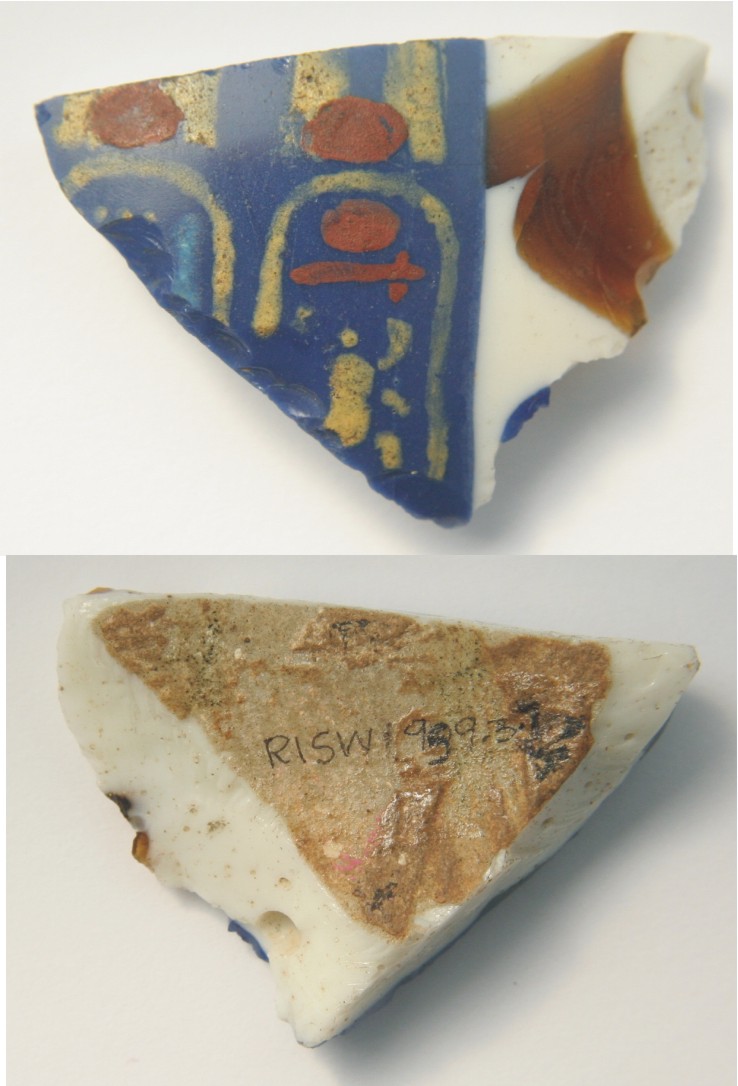SM1959.3.2

{loadposition share}
This piece of glass is on loan from Swansea Museum. The name on it is that of King Amenhotep II (1427-1401 BC). It is important because:
as it is an early example of high status glass,
because we know where it is from
because it is useful for showing how such glass was made.
It displays two names of the king in cartouches. On the right is the name ‘Great are the Manifestations of Re’ and on the left part of the name which would have read ‘Ruler of Heliopolis’.
The glass fragment was given to Swansea Museum in 1959. Circumstantial evidence originally suggested that it came from the tomb of queen Tiye (wife of king Amenhotep III). Kate Bosse-Griffiths (1961) wrote an article about this and other items from the tomb. It had been given to Swansea Museum by Miss Annie Sprake Jones of Abergwili who received it from her brother Harold Jones. Harold Jones had been employed as an artist in the tombs of the Valley of the Kings in the early 20thcentury.
However, as Cyril Aldred pointed out in 1962, it is unlikely that this piece of glass actually came from the tomb of Queen Tiye. It is more likely that it came from the tomb of Amenhotep II. Kate and others were in agreement.
The tomb of Amenhotep II was uncovered in the 1890s and at the time was particularly important. Before the discovery of the tomb of Tutankhamun, Amenhotep’s tomb was the only Egyptian tomb to have been with the body of the king, intact, still in his sarcophagus. The tomb itself, however, was not intact but also contained the bodies of other individuals who had been placed their in ancient times. It had also been looted in ancient times. Among the fragmentary items were the remains of at least 76 glass vessels, an exciting find as glass working was in its infancy at the time of Amenhotep II.
It was realised that the Swansea Museum fragment was a part of one of these glass vessels and more specifically it was clear that it came from a particularly fine specimen, now reconstructed in Cairo Museum (CG 24804).
This is the vessel as reconstructed (the copyright belongs to Birgit Schlick-Nolte). It has a separate foot. The complete vessel measures some 40cm in height. Such large vessels were not again attempted by Egyptian craftsmen until hundreds of years later.
German Egyptologist, Birgit Schlick-Nolte recently contacted the Egypt Centre and Swansea Museum as she was interested in the manufacture of early Egyptian glass.
Glass of this date is extremely rare in Egypt and was often given as diplomatic gifts between the kings of the region. Vessels and other artefacts from the reign of Amenhotep II are part of an extraordinary array of sophisticated techniques from an innovative period of glass production. Large vessels such as that in the Cairo Museum, from which our fragment originated were not even attempted in later years. At this date the manufacture of glass was a royal monopoly and valuable like gold and silver.
The fact that the Swansea Museum piece was broken meant the cross-section could be seen which revealed clues as to how the vessel was manufactured with the name of the king. The Swansea piece with the king’s name would have been prefabricated and placed upon the body of the vessel while it was still in a molten state. Interestingly, one of the names for glass in ancient Egyptian was ‘the stone that flows’.” The complete vessel would have been made on a core of clay and dung.
Other early glass in the Egypt Centre